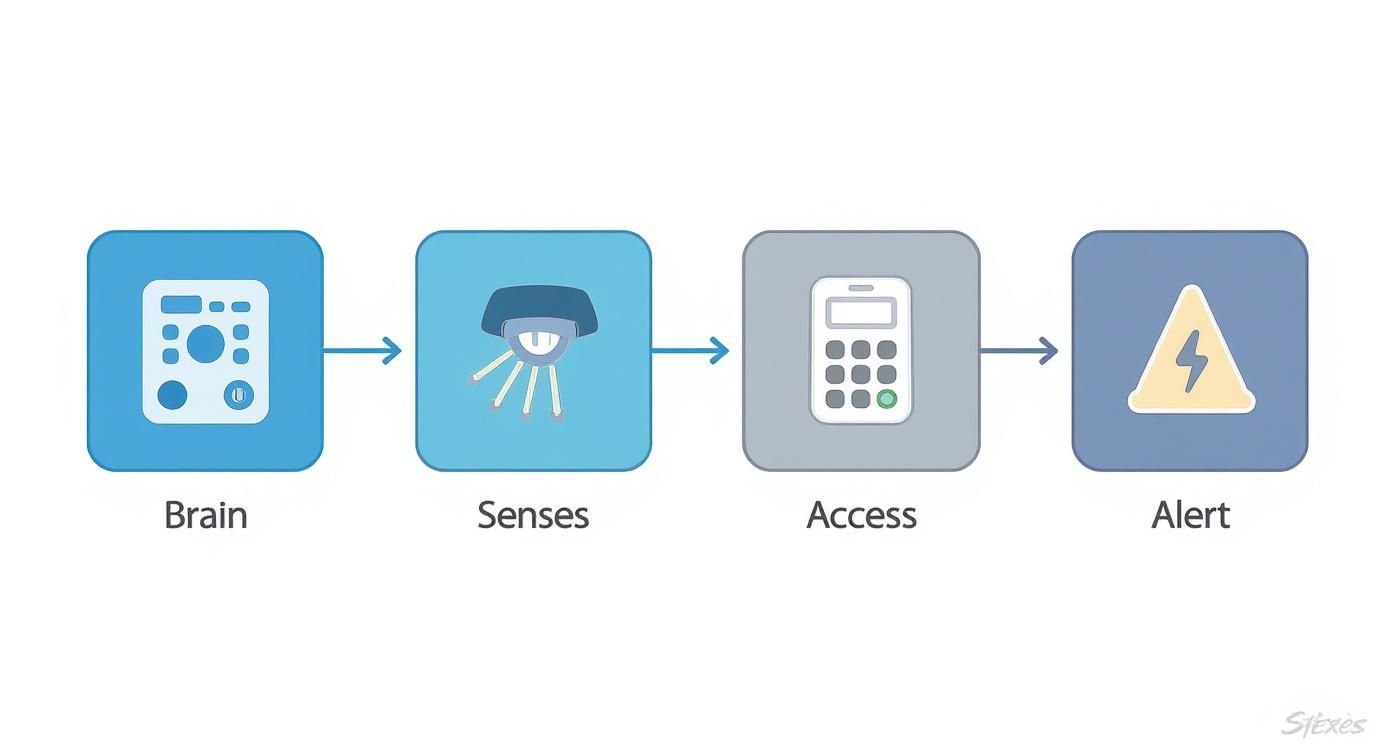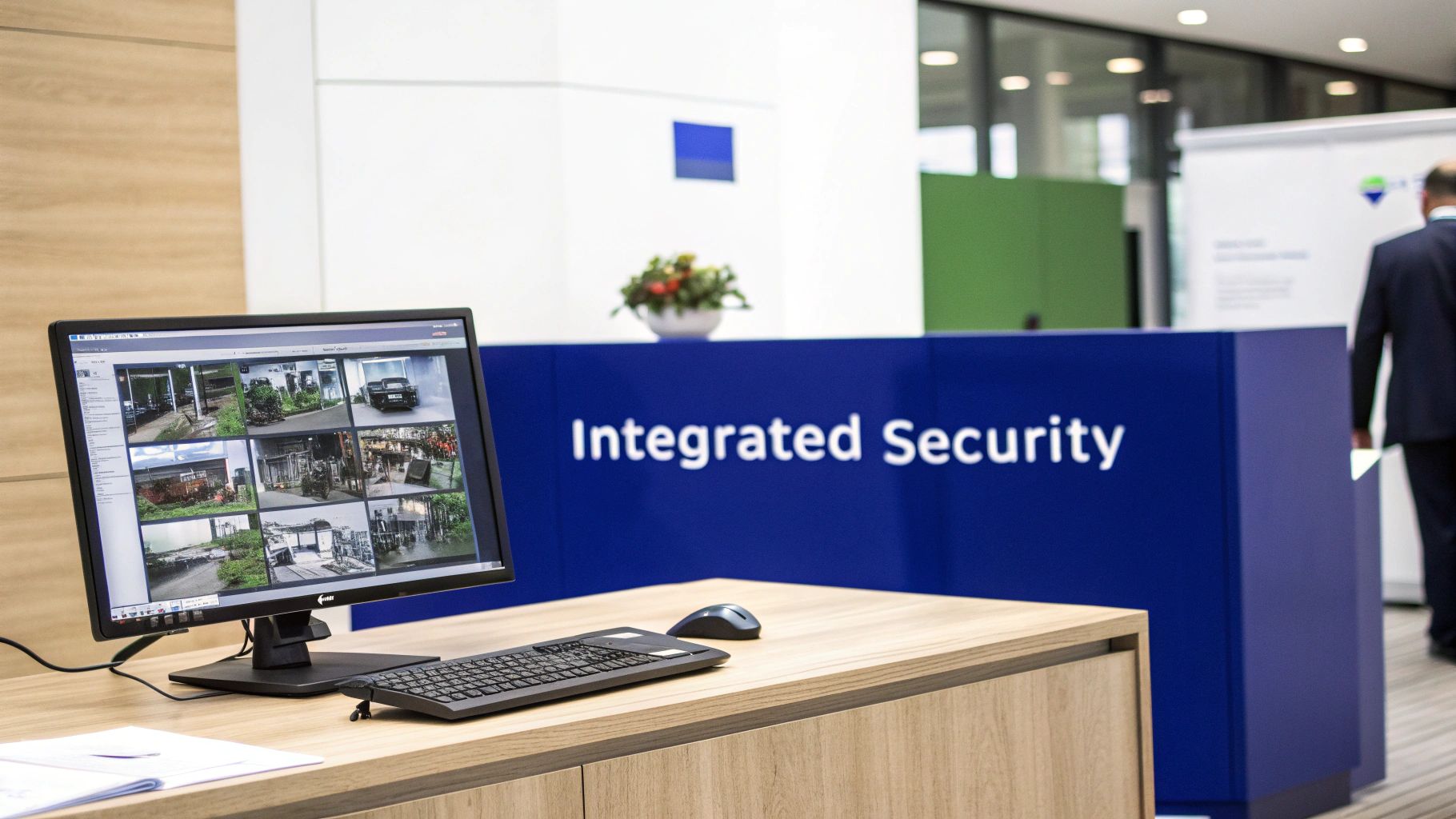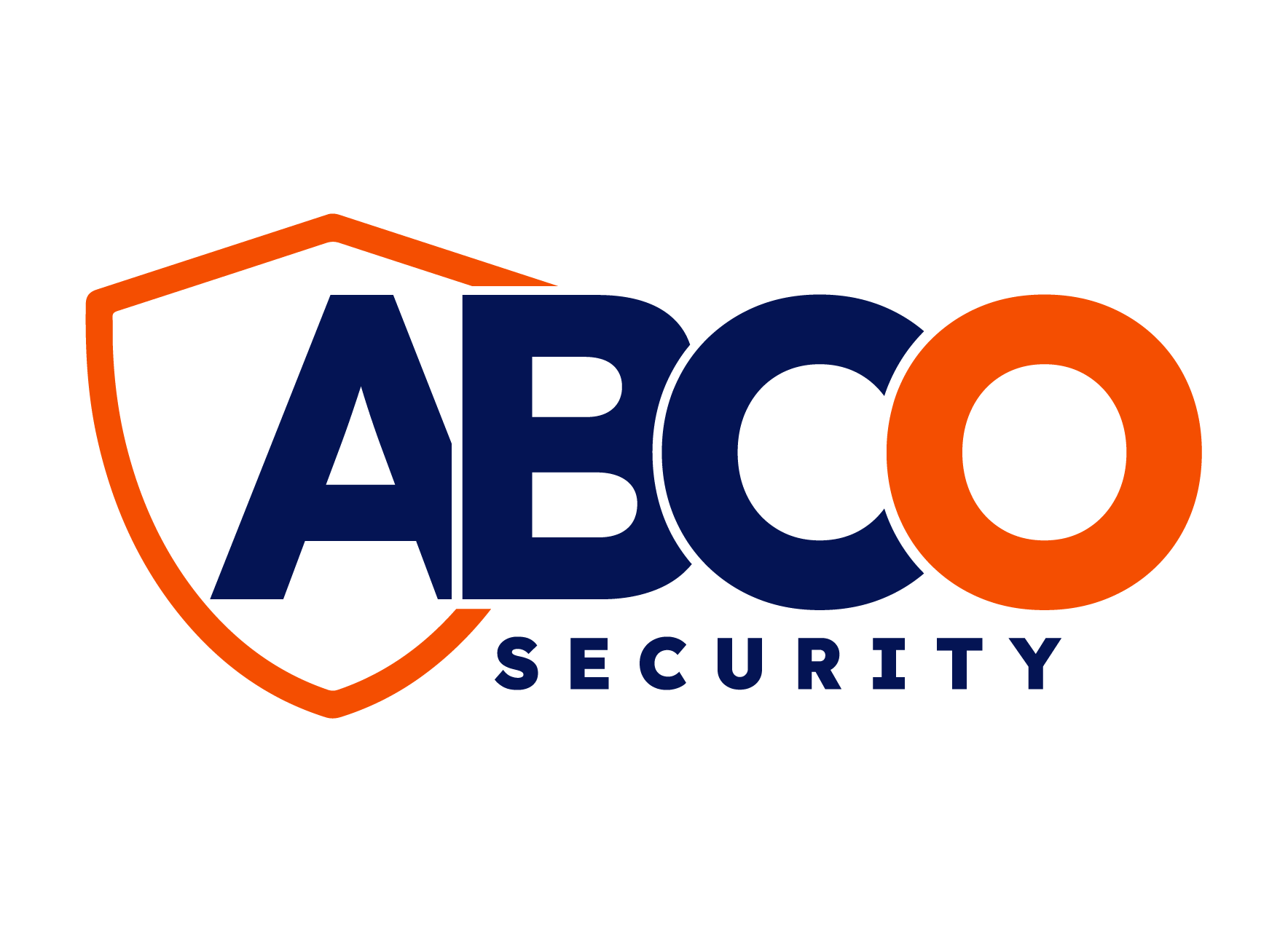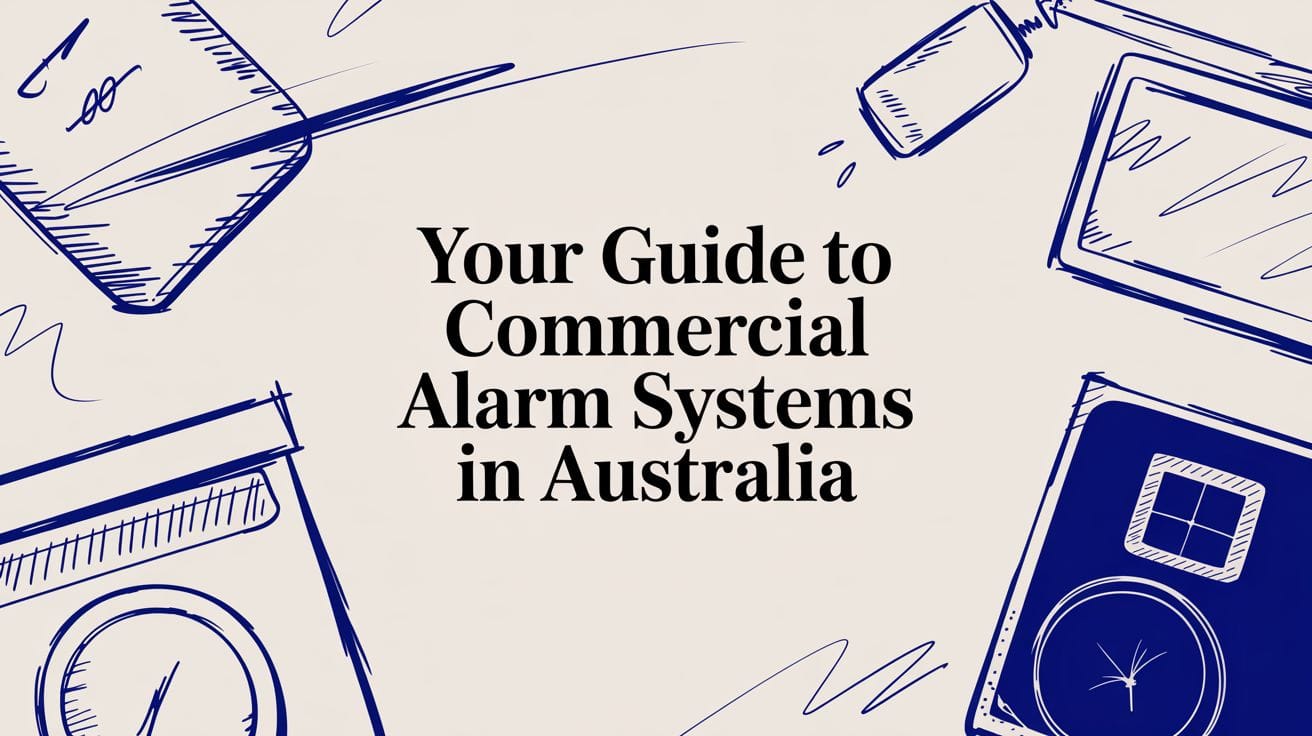
A modern commercial alarm system is far more than a simple siren on the wall. It is the central nervous system for your business's security—an integrated network designed to detect threats, deter criminals, and launch an immediate, professional response. An expertly designed system is a critical investment in risk management for any Australian organisation.
Why Modern Commercial Alarm Systems Are Essential
Imagine your business premises as a fortress. An old-fashioned alarm is like a single guard ringing a bell. A modern commercial system, however, is the command centre, orchestrating every part of your defence. It is a proactive security ecosystem that provides intelligent, layered protection to safeguard your assets and team.
This shift towards smarter security is evident across Australia. The national security market, including commercial alarm systems, is projected to generate revenues of US$602.3 million in 2025. Businesses are demanding advanced solutions with features like remote monitoring and smart device integration.
More Than Just Intrusion Detection
A professionally installed system delivers tangible benefits that directly impact your bottom line and peace of mind. It is an investment in your organisation's stability.
Here are the key advantages:
- Active Deterrence: Visible security measures from a reputable provider make your business a less appealing target for criminals.
- Rapid, Coordinated Response: With a monitored system, an alarm trigger alerts a licenced security professional who immediately assesses the situation and dispatches help.
- Asset Protection: A reliable alarm system provides a crucial 24/7 shield against theft and vandalism, protecting inventory, equipment, and sensitive data.
- Enhanced Staff Safety: A monitored security system creates a safer working environment for your employees, particularly during opening, closing, or after-hours shifts.
A Critical Tool for Risk Management
Ultimately, these systems are a cornerstone of your organisation's risk management strategy. They actively reduce threats that could lead to financial loss, operational downtime, or reputational damage.
For high-risk environments, such as those requiring robust security for construction sites, a tailored alarm solution is non-negotiable.
Partnering with a licenced and experienced security company ensures your system is compliant, effective, and perfectly matched to your operational needs. It is a strategic move that provides genuine security you can count on.
Understanding the Core Components of a Commercial Alarm System
A commercial alarm system is a network of components, each with a specific job, working together to protect your business. When every part communicates seamlessly, you get a powerful, unified defence.
The control panel is the 'brain' of the operation. This central hub processes information from all sensors and devices, analyses the data, and initiates a response, such as alerting a monitoring centre or triggering sirens.
The Eyes and Ears of Your Security System
Sensors are the frontline of your system, constantly watching for any sign of trouble. A well-designed setup uses a strategic mix of different sensors to cover all vulnerabilities.
Common sensor types include:
- Motion Detectors: Utilising infrared or microwave technology, these are ideal for covering large open areas like warehouses or offices.
- Door and Window Contacts: These simple but effective magnetic contacts trigger the alarm the moment a secured entry point is opened.
- Glass-Break Sensors: These sensors are tuned to the specific frequency of shattering glass, making them essential for protecting shopfronts and vulnerable windows.
Each sensor feeds live information back to the control panel, creating a layered defence that ensures comprehensive coverage.
Access Control and Alert Components
While sensors detect threats, other components manage access and generate alerts when an incident occurs.
The keypad allows your team to arm and disarm the system. Modern systems often integrate keypads with access control for tighter security, providing granular control over who can enter specific areas and at what times.
If a threat is detected, the sirens and strobes create an unmissable alert. A piercing siren can disorient an intruder and draw immediate attention, while flashing strobes provide a clear visual cue that there is a problem.
Key Components and Their Functions
| Component | Primary Function | Practical Example |
|---|---|---|
| Control Panel | The central 'brain' that processes signals and initiates a response. | When a window sensor is triggered, the panel sends an alert to the monitoring centre. |
| Sensors | Detect unauthorised entry or specific threats like movement or broken glass. | A motion detector in a stockroom senses movement after hours and signals the control panel. |
| Keypad | Allows authorised users to arm and disarm the system with a code or access card. | An employee enters their unique code at the start of the day to disarm the system. |
| Sirens & Strobes | Create an audible and visual alert to deter intruders and notify people of an alarm. | A loud siren sounds and a bright light flashes when a break-in is detected. |
| Monitoring Connection | Communicates alarm signals to a 24/7 professional monitoring centre. | The system uses a 4G or internet connection to instantly notify security personnel of a fire alarm. |
A truly effective security system is more than the sum of its parts. It is how these components are professionally selected, installed, and configured that creates a reliable shield for your business.
This synergy is the foundation of modern electronic security. According to the Australian Security Industry Association Limited (ASIAL), Australia's peak security body, adherence to industry standards is non-negotiable for system reliability. Working with a licenced provider ensures every component is installed correctly, minimising false alarms and maximising protection.
Exploring Different Types of Commercial Alarms
Choosing the right system requires understanding your property's unique risks and how different technologies can mitigate them. It is not a one-size-fits-all decision. Let's break down the main options to help you make an informed choice.
A wired alarm system is the traditional approach, where every component is physically connected by cables. This creates an incredibly stable and interference-proof network, making it an excellent choice for new constructions or during major renovations.
Conversely, wireless systems use secure, encrypted radio signals to connect components. Their main advantage is flexibility, allowing for installation in existing or heritage-listed properties where running cables is impractical. Modern commercial-grade wireless systems are highly reliable, with long-life batteries and built-in fail-safes.
Unmonitored vs. Professionally Monitored Alarms
The most crucial difference is what happens when an alarm is triggered. An unmonitored alarm is a local noisemaker, relying on a neighbour or passer-by to contact the police—a significant gamble for any business.
A professionally monitored system is the industry standard for commercial security.
When a monitored alarm is triggered, it sends a critical alert to a team of trained security professionals ready to act immediately. They can verify the threat and dispatch help within moments.
This infographic provides a clear overview of how a comprehensive alarm system works, from detection to response.
The connection to a monitoring centre transforms a simple alert into a decisive security response. You can explore the details of professional CCTV and alarm monitoring services to see how this immediate intervention works.
The Power of Integrated Security Systems
A standalone alarm is good, but an integrated system builds truly layered, intelligent security. This means bringing your alarm, CCTV cameras, and access control together under a single, unified platform, making your security proactive rather than just reactive.
The benefits of integration are significant:
- Visual Verification: If a motion sensor is tripped, an integrated system can instantly display the feed from the nearest camera, allowing the monitoring team to visually confirm a threat and provide critical information to police.
- Smarter Access Control: Link your alarm to door and gate access. The system can automatically lock down a sensitive area when the main alarm is armed or log which staff member disarmed the system and at what time.
- Streamlined Incident Response: An integrated system provides a full story of any incident, recording who entered, where they went, and what they did, which is invaluable for any investigation.
Matching the System to Your Business Environment
The best setup is one designed for your specific environment. A licenced security expert will analyse your unique vulnerabilities to recommend the right combination of technology.
- Retail Store: A mix of door contacts, glass-break sensors, and motion detectors is essential. Integrating this with CCTV is crucial for capturing evidence of theft or vandalism.
- Office Building: An integrated alarm and access control system is key for securing high-value areas, monitoring after-hours access, and managing employee permissions.
- Warehouse: This requires a robust solution, including perimeter protection, wide-area motion sensors, and monitored smoke detectors, paired with high-definition CCTV.
Understanding these different system types is the first step toward building a commercial alarm solution that offers genuine peace of mind.
How to Choose the Right Alarm System for Your Business
Selecting a business alarm system is a strategic security decision. You are not just buying a product; you are implementing a security solution tailored to your organisation's unique risks, layout, and daily operations. A generic system is insufficient; you need a solution designed by professionals.
Start with a Professional Security Risk Assessment
The first and most important step is a professional security risk assessment. A licenced technician will conduct a thorough on-site evaluation to identify every vulnerability, from unlocked doors and CCTV blind spots to areas holding high-value assets. This analysis becomes the blueprint for your security system.
A qualified expert will evaluate several key factors:
- Property Layout and Size: A multi-storey office has different needs than a sprawling warehouse. The assessment determines optimal sensor types and placement.
- Operational Hours: A 24/7 operation requires a system that can be armed in different zones, securing unused areas while other parts remain active.
- Asset Identification: Understanding what you are protecting—whether physical stock, data, or machinery—dictates the level of security required.
- Existing Vulnerabilities: An expert has a trained eye for weaknesses you might miss, such as unsecured service entrances or poorly lit perimeters.
This process ensures your commercial alarm systems are built on real-world insights, not guesswork.
Consider Compliance and Insurance Requirements
Before committing to a system, review your insurance policy. Many insurers offer premium discounts for professionally installed and monitored alarm systems but often have strict requirements. Failure to meet these standards could result in a denied claim after a break-in.
Working with a licenced Security Company Melbourne ensures your setup meets all necessary Australian Standards and satisfies your insurer's requirements, protecting you from both physical and financial loss.
Plan for Future Growth and Scalability
Your business will evolve, and your security system must be ready to adapt. Choosing a scalable system from day one saves money and hassle down the road.
A scalable system is designed with the future in mind. It allows you to easily add new sensors, cameras, or access control points without replacing the entire infrastructure. This adaptability is the hallmark of a well-designed security solution.
Thinking ahead ensures your investment provides long-term value. You can learn more about the growth in the Australian security market to understand current trends.
Partnering with a trusted, licenced security provider is the best way forward. They possess the expertise to navigate risk assessments, compliance, and technology, delivering a customised security strategy.
Ready to find the perfect security solution for your business? Book a consultation with our expert team to get a customised assessment.
Why Professional Installation and Maintenance Are Crucial
A high-quality commercial alarm system is only as reliable as its installation and maintenance. While a DIY approach may seem cost-effective, it often leads to critical errors that leave your business vulnerable. A licenced professional provides expertise that ensures maximum effectiveness.
Expert installation is a precise science. It involves strategically placing every component to eliminate blind spots and ensure wiring is tamper-proof. Professionals also calibrate the system to minimise frustrating and potentially costly false alarms.
The Critical Role of a Licenced Installer
For any serious business, using a licenced security installer is non-negotiable. In Australia, licenced professionals are held to strict industry standards, ensuring they have the technical knowledge and ethical grounding to secure your premises correctly.
A professional installation guarantees:
- Optimal Sensor Placement: Technicians identify the most effective locations for sensors based on your building's unique layout and vulnerabilities.
- Secure and Compliant Wiring: All cabling is run discreetly and securely to prevent tampering and meet all Australian electrical and security standards.
- System Calibration: Your system is fine-tuned to your specific environment, dramatically reducing false alarms from non-threats like drafts or pets.
An improperly installed alarm provides a false sense of security. Professional installation ensures every component works exactly as it should when you need it most.
Ongoing Maintenance: An Essential Security Practice
Security technology is not a "set and forget" solution. Regular maintenance is the only way to guarantee your system remains reliable, compliant, and effective for years to come.
Think of it like servicing a company vehicle. Without routine maintenance, components can fail, batteries can die, and software can become outdated. Professional installation and ongoing maintenance are also crucial for adhering to current fire alarm standards.
A scheduled maintenance plan from a qualified technician typically includes:
- Testing all sensors and detectors to confirm proper communication with the control panel.
- Checking battery levels and power supplies to prevent unexpected system failures.
- Updating firmware to patch vulnerabilities and ensure peak performance.
- Verifying communication links to your back-to-base monitoring centre.
This proactive approach ensures your investment continues to deliver the protection your business deserves. In some situations, this can be supported by on-site personnel, such as professional security guard services, to create a seamless response.
Integrating Alarms for a Strategic Security Solution
A commercial alarm system is a powerful tool, but its true potential is realised when integrated with other security measures. This approach moves you from simple alerts to an intelligent, responsive security strategy for your business.
An integrated system provides context. For example, when an alarm sounds, it can trigger cameras to provide visual verification. This allows your monitoring centre to confirm if it is a genuine break-in or a false alarm, ensuring police are only dispatched when necessary.
Unifying Alarms with Access Control
Pairing your alarm with access control gives you superior command over your premises. The system can be configured to automatically arm in certain areas when the last authorised employee leaves or instantly lock all doors during a security event.
If an alarm is triggered at a side entrance, an integrated system can cross-reference it with access logs in a split second. This tells you whose keycard was used, providing invaluable data for any investigation. This is where your Security Company Melbourne becomes a true partner, designing a system where every piece fits together. Many businesses use robust integrated access control solutions for this purpose.
From Alert to Action with Mobile Security Patrols
Integration closes the gap between an electronic alert and a real-world response. When an alarm is triggered and visually confirmed, the system can automatically dispatch a mobile security patrol to your property.
A licenced guard can secure the site, liaise with law enforcement, and provide a full incident report. This transforms your alarm from a passive warning device into an active protection force, ensuring a rapid physical presence on the ground.
An integrated security strategy ensures that every component—from the alarm sensor to the patrol officer—is part of a coordinated response. It is how you actively protect assets and ensure a swift resolution.
The Benefits of a Layered Security Approach
Connecting your alarm system with other security services builds layers of protection that are far more effective than any single tool.
- Reduce False Alarms: Visual verification allows monitoring staff to quickly dismiss false triggers, saving you from call-out fees and unnecessary downtime.
- Gather Clear Evidence: Combining alarm data, video footage, and access logs creates a complete record of any incident, which is invaluable for police reports and insurance claims.
- Achieve a Faster, Smarter Response: Verified alarms receive a higher priority from emergency services, and a dispatched security patrol ensures a professional is on-site quickly.
This integrated approach makes your security work smarter, ensuring an immediate and effective response when an alarm is triggered.
Common Questions About Commercial Alarm Systems
It is natural to have questions when investing in security for your organisation. We have compiled answers to common queries from business owners, based on our extensive experience in the Australian security industry. Our goal is to provide clear, practical information to help you feel confident in your security plan.
What Happens When My Monitored Alarm Is Triggered?
When an alarm is triggered, a secure signal is sent to our 24/7, A1 Grade monitoring centre. Our trained operators immediately assess the situation and execute your pre-approved, customised response plan.
This action plan, determined by you in advance, may include:
- Contacting you or your designated keyholders.
- Using integrated CCTV to visually verify the threat.
- Dispatching a mobile security patrol to your premises.
- Notifying police or other emergency services.
This process guarantees a rapid, professional reaction every time. It is the core value of having dedicated Melbourne security services protecting your business.
How Can I Prevent False Alarms at My Business?
Minimising false alarms is essential for maintaining system credibility and avoiding unnecessary fees. The best approach combines professional installation, regular system maintenance, and proper staff training.
Our licenced technicians strategically place sensors to avoid accidental triggers from sources like air conditioning or shifting stock. Additionally, modern commercial alarm systems feature smart verification technology that helps differentiate between genuine threats and minor disturbances, dramatically reducing false activations.
Is a Wireless Alarm System Reliable for a Business?
Absolutely. Today's commercial-grade wireless systems are highly reliable and secure. They use powerful, encrypted signals to prevent interference and are equipped with long-life batteries that include fail-safes and low-power notifications.
While a wired system is often ideal for new constructions, modern wireless technology offers excellent flexibility without compromising performance. It is a perfect solution for existing or heritage-listed properties where cabling is impractical. A professional security assessment will identify the best fit for your site.
Ready to secure your business with a system you can trust? The expert team at ABCO Security Services Australia is here to design, install, and maintain a solution that perfectly fits your operational needs.
